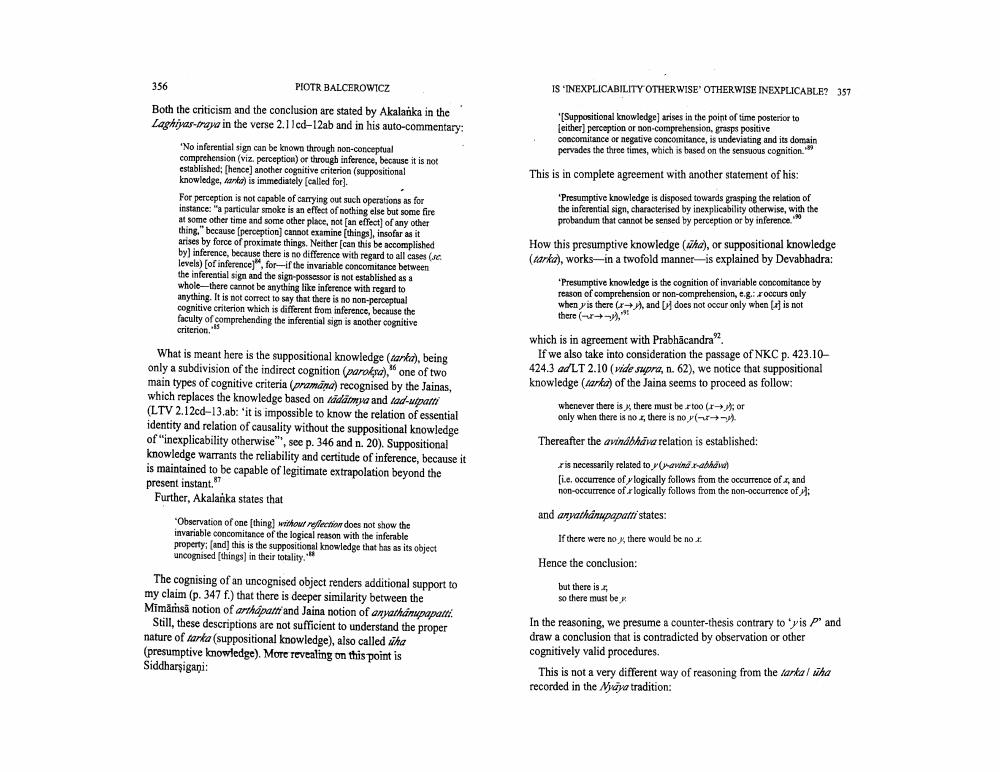________________
356
PIOTR BALCEROWICZ
Both the criticism and the conclusion are stated by Akalanka in the Laghiyas-traya in the verse 2.11cd-12ab and in his auto-commentary:
'No inferential sign can be known through non-conceptual comprehension (viz. perception) or through inference, because it is not established; [hence] another cognitive criterion (suppositional knowledge, tanka) is immediately (called for].
For perception is not capable of carrying out such operations as for instance: "a particular smoke is an effect of nothing else but some fire at some other time and some other place, not [an effect] of any other thing," because [perception] cannot examine (things], insofar as it arises by force of proximate things. Neither [can this be accomplished by] inference, because there is no difference with regard to all cases (e levels) [of inference), for-if the invariable concomitance between the inferential sign and the sign-possessor is not established as a whole there cannot be anything like inference with regard to anything. It is not correct to say that there is no non-perceptual cognitive criterion which is different from inference, because the faculty of comprehending the inferential sign is another cognitive
criterion.
What is meant here is the suppositional knowledge (tanka), being only a subdivision of the indirect cognition (paroksa)," one of two main types of cognitive criteria (pramana) recognised by the Jainas, which replaces the knowledge based on tädätmya and tad-utpatti (LTV 2.12cd-13.ab: 'it is impossible to know the relation of essential identity and relation of causality without the suppositional knowledge of "inexplicability otherwise", see p. 346 and n. 20). Suppositional knowledge warrants the reliability and certitude of inference, because it is maintained to be capable of legitimate extrapolation beyond the present instant.87
Further, Akalanka states that
"Observation of one [thing] without reflection does not show the invariable concomitance of the logical reason with the inferable property: [and] this is the suppositional knowledge that has as its object uncognised [things] in their totality.
The cognising of an uncognised object renders additional support to my claim (p. 347 f.) that there is deeper similarity between the Mimämsä notion of arthápatti and Jaina notion of anyathanupapatti. Still, these descriptions are not sufficient to understand the proper nature of tarka (suppositional knowledge), also called üha (presumptive knowledge). More revealing on this point is Siddharṣigani:
IS INEXPLICABILITY OTHERWISE OTHERWISE INEXPLICABLE? 357
"[Suppositional knowledge] arises in the point of time posterior to [either] perception or non-comprehension, grasps positive concomitance or negative concomitance, is undeviating and its domain pervades the three times, which is based on the sensuous cognition
This is in complete agreement with another statement of his:
'Presumptive knowledge is disposed towards grasping the relation of the inferential sign, characterised by inexplicability otherwise, with the probandum that cannot be sensed by perception or by inference.
How this presumptive knowledge (ha), or suppositional knowledge (tarka), works in a twofold manner is explained by Devabhadra:
*Presumptive knowledge is the cognition of invariable concomitance by reason of comprehension or non-comprehension, e.g.: occurs only when y is there (r), and [ does not occur only when [] is not there (→→→→),
which is in agreement with Prabhācandra".
If we also take into consideration the passage of NKC p. 423.10424.3 ad LT 2.10 (vide supra, n. 62), we notice that suppositional knowledge (tarka) of the Jaina seems to proceed as follow:
whenever there is y, there must be rtoo (r→); or only when there is no, there is no y()).
Thereafter the avindbhāva relation is established:
r is necessarily related to y(avina x-abhava)
[ie, occurrence of y logically follows from the occurrence of x, and non-occurrence of r logically follows from the non-occurrence of ;
and anyathanupapatti states:
If there were no y, there would be no r.
Hence the conclusion:
but there is x, so there must be
In the reasoning, we presume a counter-thesis contrary to 'yis P' and draw a conclusion that is contradicted by observation or other cognitively valid procedures.
This is not a very different way of reasoning from the tarka üha recorded in the Myaya tradition:




